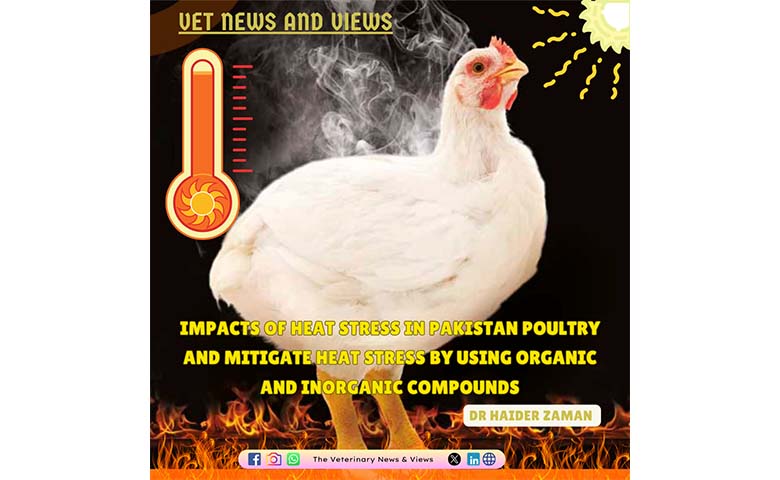Written By Dr Haider Zaman, Master Researcher, MNS University of Agriculture Multan, Pakistan.
Pakistan’s poultry industry is one of the most distinct and fascinating aspects of agriculture, accounting for 1.4% of countrywide country’s gross domestic product. As per a Pakistan economic assessment, this sector employed more than 1.5 million people in the country. The poultry industry has developed at an impressive 7.5% each year, with an all-out speculation of more than RS 750 billion. The evaluated commercial poultry meat production in the financial year (2022) is 1846.48 metric tons (Economic survey of Pakistan 2022).
Heat stress is a physiological state that monitors when the body aptitude can’t possess a permanency between heat creation and heat degeneracy. Heat stress is a risk that can prompt huge monetary misfortunes in the development of poultry on the world’s tropical and dry districts.
The level of intensity stress (gentle, moderate, extreme) experienced by poultry relies basically upon warm radiation, adhesiveness, the being’s thermoregulatory capacity, metabolic rate, age, strength, and period of the intensity stress. Existing business meat type chickens have a quick digestion, which makes them produce higher intensity and be inclined to warm pressure. The adverse consequence of intensity weight on poultry birds’ physiology, wellbeing, establishment, government assistance and ways of behaving.
Elongated periods of power shortage, poor excellence feedstuff with mycotoxins, shortage of proper biosecurity strategies and inconsistent prices, affected excessive loss to the progression of the poultry productiveness in Pakistan. Heat stress in poultry is a serious issue that can significantly impact the health and productivity of birds. It occurs when the bird’s body temperature exceeds the normal range (104-106°F/40-41°C) due to exposure to high environmental temperatures, humidity, and other stressors.
Causes of heat stress in poultry: High temperatures and humidity, inadequate ventilation and air quality, Overcrowding, Poor nutrition and water quality, Genetic factors.
Heat stress in birds is characteristically named as intense (27-38°C for 1-24 hours), moderate (27-38°C for 7 days) and persistent (38-50°C for 7 days or more).
Heat stress weakens poultry development and competency, as well as productive qualities, generative and prosperity. Body temperature above the comfort zone has an unfavorable consequence and upsets morphological homeostasis, suppresses the action of digestive resistance and in this way causes gastrointestinal tract swelling in broiler. Thus, birds become unnatural and the mortality rate rises
Signs and symptoms: Panting and rapid breathing, Increased water consumption, Decreased feed intake and productivity, Lethargy and depression, Increased mortality.
Consequences: Reduced growth rates and egg production, increased susceptibility to diseases, decreased immune function, and Economic losses for poultry producers.
Strategies for prevention and management: Provide adequate ventilation and cooling systems, Ensure access to clean water and shade implement stress-reducing management practices (e.g., reduced stocking density), Monitor temperature and humidity regularly, Consider using heat-tolerant breeds or genetic lines Use of organic and inorganic compounds
Organic compounds such as vitamin C, betaine and vinegar have gained much importance in order to mitigate the negative impact of heat pressure in severe stress circumstances. Inorganic compounds such as sodium bicarbonate supplemented in drinking water improved feed intake and growth performance during heat stress. L-ascorbic acid is a water-dissolvable nutrient with hostile to oxidant action, safeguarding living being under stress. L-ascorbic acid is fundamental for internal heat level and supporting resistance. L-ascorbic acid supplementation was found to ease the adverse consequence of weight on metabolic interaction and improves foundation.

One more significant disease prevention agent used to reduce the adverse consequences of HS is L-ascorbic acid. Since L-ascorbic acid is definitely not a fundamental supplement for poultry, no necessity was laid out by the NRC. Then again, Aviagen has suggested expanding the nutrient supplementation by 2.5% per extra degree Celsius when the surrounding temperature exceeds 28 °C. It has been accounted for that ecological stressors, particularly HS, can prompt lacking endogenous blend, expanding the requirement for exogenous L-ascorbic acid. Ascorbic acid, or vitamin C, is a water-soluble natural antioxidant that also has anti-oxidant properties that help guard animals from heat stress. Vitamins C and E worked together to lessen the negative effects of CHS in hens. Betaine has cell reinforcement capability that can diminish oxidative pressure in meat type chickens under HS. Meat type chicken Ross 308 with provision of vinegar (10 ml/liter of water) could mitigate oxidative stress level. Vitamin E: Improves immunity, reduces liver damage, and facilitates egg production. Vitamin C: Enhances immunity, improves growth rate, and reduces oxidative stress. Zinc: Essential for metallothionein synthesis, acts as a free radical scavenger, and improves eggshell mineralization. Chromium: Involved in carbohydrate, protein, lipid, and nucleic acid metabolism; improves body weight, feed intake, and carcass quality. Selenium: Acts as an antioxidant improves live weight, and enhances productive and reproductive performance. Electrolytes: Help maintain acid-base balance and blood pH; sodium bicarbonate (NaHCO3) is commonly used. Sodium: Helps maintain blood pH and blood HCO3-, and improves eggshell quality. Potassium: Essential for maintaining acid-base balance and blood pH. Chloride: Helps reduce blood pH and blood HCO3-Feed restriction: Reduces heat production and improves feed efficiency. Dual feeding regime: Provides a protein-rich diet during cooler times and an energy-rich diet during warmer periods. Wet feeding: Increases water intake, improves nutrient absorption, and reduces viscosity in the gut. Adding fat in the diet: Increases energy levels and reduces the detrimental effects of heat stress. Uses of organic and inorganic compounds have significant impact during heat stress and poultry welfare traits. It also have significant role in poultry production and growth performance in chickens.